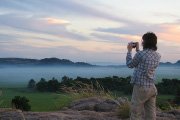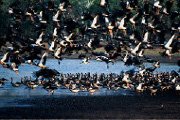Paperbark tree
Kakadu’s elegant paperbark forests are one of the park’s most recognisable features.
There are three main species of paperbark in Kakadu: the silver-leafed paperbark, broad-leafed paperbark and weeping paperbark.
These trees fringe Kakadu’s floodplains, swamps and other waterways. They offer nesting sites for birds such as black-necked storks, white-bellied sea-eagles, whistling kites, green pygmy geese, brush cuckoos and flycatchers. Honeyeaters and lorikeets feed on the nectar, while forest kingfishers and blue-winged kookaburras can often be seen darting through paperbark forests.
Paperbark forests also provide a haven for agile wallabies, who have to leave the safety of the trees to drink and graze at the water’s edge.
Culture
Bininj/Mungguy use the bark of the tree for bedding, bandages, shelter, rafts, containers and more.
The leaves add flavour to cooking, and a traditional ground oven will often include layers of paperbark leaves.
Scientific name
Melaleuca argentea (silver-leafed paperbark), Melaleuca viridiflora (broad-leafed paperbark), Melaleuca leucadendra (weeping paperbark)
Take the first step
A journey of 1000 miles begins with a single click.
Enter your email to get free trip planning advice from Kakadu rangers.





